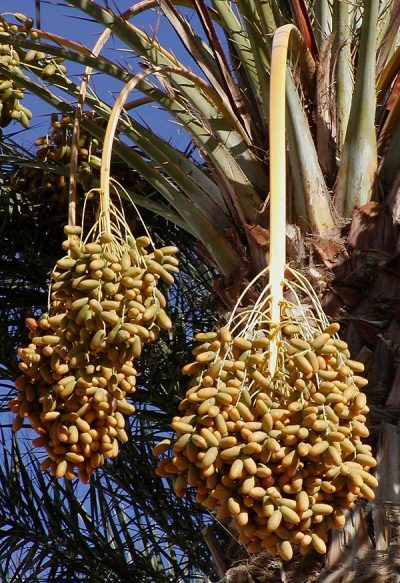The date tree of Egypt: ‘Bread of the desert’
The date tree of Egypt: ‘Bread of the desert’
The date tree of Egypt: ‘Bread of the desert’
-
Hannah
-
Hannah

Have you ever tried a date? They are deliciously sweet.
It is thought that the date palm originated in the area that is now Iraq many, many years ago: in fact, this tree of the desert is the oldest plant cultivated by people. We have plenty of evidence to show that the date was consumed and used in rituals all the way back to the beginning of the Dynastic Period in Egypt, and even before.
Today, Egypt is the top producer of dates in the world. The tree, which can grow for up to 150 years, is valuable for its timber, its leaves, its stalks and its seeds – but of course the fruits are the most valuable. A single tree, reaching as high as 23 metres in height, can yield more than 40 to 80 kilograms of dates; one bunch can contain up to 1,000 dates.

This ‘bread of the desert’ is so called because it is a staple for the Bedouins of the desert (who, in fact, make bread with the dates). The date tree has since antiquity been a source of nourishment in the desert, and, through harvesting, for the people of Egypt. Pharaohs would eat them for desert, and drink their juice infused in wine and beer. The palms featured in gardens; the fruits were left as offerings at tombs and temples. They were also used in medicine, to relieve swelling and alleviate coughs.
Dates aren’t just delicious; they’re healthy, full of potassium, B vitamins and various minerals. They give you an excellent boost if you are suffering from tiredness. You can eat simple dried (or fresh) dates, and across the world you’ll find different fillings, from nuts to candied orange, marzipan to tahini, and different coverings, from sugar syrup to – very tasty – chocolate. The Americans make date nut bread; the Moroccans add dates to tagines; the British use dates in sticky toffee pudding and traditional Christmas puddings.
Can I say that the Egyptians do it best? A bit cheeky, perhaps, but then we do have a long history of growing date palms. Here’s my favourite recipe for dates, based on one found inscribed on Ancient Egyptian pottery.
On the stove, gently warm three tablespoons of local honey. Add a couple of drops of water and 200 grams of dates, de-stoned and mashed up. Add a teaspoon of ground cinnamon and mould into little balls. Roll each in some ground almonds. (You can also add chopped nuts to the mixture if you like; add a little extra honey/water to help them stick.)
Of course, I could not write a book set in Egypt without including date palms in the scenery. Here’s a little glimpse of how they fit into the landscape, from Song of the Nile:
The sky was flooded with light, against which the tall date palms stood out as though etched upon their background by some fairy hand. The scene was one of enchantment…

Song of the Nile: available to buy now
Photo credits: 1) Protasov AN/Shutterstock.com; 2) Stan Shebs/Wikipedia.